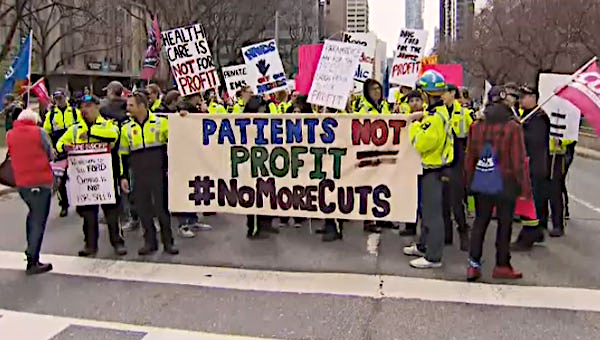A recent book, The Body Economic: Why Austerity Kills, makes the reasonable point that, “the price of austerity can be measured in human lives.”[1] Austerity programs have obvious negative impacts on well being when public health programs are cut but it also creates poor health in less obvious ways through the stress of a labour market involving high unemployment and a decimated safety net. A quick glance at the history of the United States can help demonstrate that it is not only recent austerity programs that kill but, rather, that when economic policies favour the business community, death and disease will follow. In fact, a reasonable case could be made that ill health and early death are more a result of economics and politics than germs and genes.

The epidemiological transition describes the transformation in what kills people from infectious disease in the 19th century to chronic disease in the 20th. The popular understanding of this transition is that the germs that caused infectious disease mortality were defeated by the ‘magic bullets’ of mainstream medicine over the course of the 20th century, permitting the population to get old enough to get heart disease and cancer. This is unambiguously false. The biomedical approach did not provide the solution for infectious disease and neither biomedical nor behavioral approaches have been successful in explaining the rise in chronic disease or very effective at curing it.
The idea that medical cures were responsible for improvement in human health during the infectious disease stage was most famously, and successfully, challenged by Thomas McKeown.[2] McKeown argued that the transition away from infectious disease and decreased mortality was not due either to medical advance or public health. The single determining factor was broad based income gains for people and the corresponding increase in nutrition. Critics of McKeown successfully argued that other factors like the decline in the length of the working day and sanitation mattered as well. No one can make a legitimate argument that technical advances in medicine and drugs were responsible because its interventions were simply chronologically too late to explain the decline in infectious disease rates.
The question that follows is what is the etiology of these economic conditions underlying infectious disease and how were they overcome?
A History of Infectious Disease: Underpaid, Overworked and Unsanitary
Early capitalism resulted in workers and their families being underfed and overworked, inhibiting their inborn and acquired immune system from working effectively. This created an ‘epidemic constitution’ for infectious disease. Few would have envied the position of the unskilled worker in early industrializing America. In 1880, about forty-five per cent of workers could, if they remained lucky enough to avoid the twin working-class disasters of illness or accident, just afford the basic necessities. A further forty per cent of working families could not afford even a basic basket of necessities, and about one-quarter of these lived in absolute penury.[3] It is no wonder that younger family members were forced to work to supplement the family income. As late as 1900 there were at least 1.7 million children engaged in paid labour in the United States.[4]
Studies at the time by the U.S. Children’s Bureau showed that low incomes had an important impact on children’s health. A study in 1915 found that families where the father had an annual income of less than $450 had an infant death rate of 157 in every 1,000 births. If the father’s income was $1,850 the mortality rate was less than a quarter of that – only 37 in 1,000.[5]
In 1890 the work-week stood at a lengthy 60 hours, but as with all averages some toiled for much longer. At the legendary Homestead mill owned by Andrew Carnegie workers put in a twelve hour day every single day of the year except Christmas and, in a nod to patriotism, July 4.
Predictably, living conditions were less than ideal. New York’s Tenth Ward was said to be the most crowded district in the world; provisions for sanitation were non-existent and “cubby-hole” sized rooms doubled as workshops. As many as twelve families (not individuals) would often live on one floor. According to an investigation of Chicago tenements in 1883-1884, the streets were filled with decaying matter and filth. The housing where thousands of people lived violated all rules for drainage, plumbing, light, ventilation and safety.
Although workers struggled to win a larger share of the gains of economic growth during this period, they were violently opposed by both business and the state. Owner’s attitudes were nicely summarized by the Secretary of the Southern Industrial Convention, N.F. Thompson who stated, “Labor organizations are … the greatest menace to the government that exits … [A] law should be passed that would make it justifiable homicide for any killing that occurred in defense of any lawful occupation.”[6]
One particularly dramatic example of the state’s role in labour conflict occurred at Carnegie’s Homestead mill in July 1892. A particularly violent lockout was tilted in the firm’s favour when the arrival of the state militia ensured that strike breakers could enter the factory. Unable to stop production, and with the might of the state siding with Carnegie, workers crossed the picket line and returned to work. The union was crushed. Of the 3800 strikers only 1300 were permitted to work again and none of them belonged to the union. Wages were reduced by an astonishing fifty per cent, the work day was extended to twelve hours, and extra Sunday pay abolished. Unionism in the national steel industry came to a halt for almost forty years. In its outlines, the Homestead conflict was similar to countless others from Haymarket in Chicago to Bay View, Wisconsin. With the aid of the government, owners were generally able to resist even the most basic of workers’ demands.
Both the political and judicial arms of the state acted time and again to suppress the claims of workers and support those of capital. This was true when troops were used to ensure that replacement workers could safely be used to break strikes, and when workers were denied compensation for injuries in the courts. Infectious disease was prominent when political and economic structures favoured capital at the expense of labour so blatantly that it left a large portion of the working population virtually at death’s door. In fact, you could make a better case that state economic policy in support of private sector profits caused epidemic disease than you could that it was caused by germs.
Why Did Working and Living Conditions Improve?
Unions have given us a lot more than the weekend. Economic growth was only channeled to working-class incomes, civic improvements, and better working conditions when the populace became sufficiently mobilized that they created pressure for a redistribution of the income toward these purposes. It was resistance by labour that created a more livable workday, child labour laws and a higher wage and the resulting improvements in nutrition and housing. Consider the U.S. example.
In spite of the decimation of American unions in the late 1800s, they grew rapidly in the first part of the 20th century. In only seven years union membership increased from 447,000 in 1897 to 2,073,000 in 1904. This was not a period of labour peace. Annually, there were three times as many strikes in the early years of the 20th century as there were in the late 19th.[7]
Political parties advocating a dramatic break from the current political economy were also growing in popularity. In the 1904 Presidential election, Eugene V. Debs quadrupled his vote running on a socialist platform. The socialist vote remained constant in 1908 and then surged again in 1911. Socialists elected mayors in 73 municipalities in the United States. The threat was deemed sufficiently grave that the leading organization of big businesses in the country, the National Civic Federation (NCF), conducted a sizeable campaign against the spread of socialism. After Woodrow Wilson’s 1912 election, the Democrats consciously adopted many pro-labour platforms in an attempt to woo voters away from socialist candidates.
The Progressive period started the improvements in people’s lives that made for an increasingly inhospitable environment for infectious disease. Many of the reforms were championed by large businesses or implemented at the federal and state levels by the Democratic Party, but the only reason that these groups were interested in reform was the constant and often violent pressure from U.S. workers. Essentially the movement for reform came about due to the recognition that the status quo of the late 19th century could not be sustained without the very real threat of growing mass discontent and continued pressure for much more widespread and radical change by workers. Wages grew, hours of work fell, child labour laws passed, nutrition, housing, clothing improved and therefore infectious disease mortality declined long before the invention of immunizations or antibiotics. Infectious disease mortality declined as working-class conditions improved – a story that could be replicated in Canada and other core capitalist countries.
Death and Disease Today
People in industrialized capitalist countries do not die the way they used to. Between 1900 and 1940 as the incidence of mortality from infectious disease declined, heart disease and cancer became the new killers. Overcoming infectious disease came at a price. Rising wages and profits are only possible with accompanying increases in productivity, or getting more value out of each hour of labour. The transformation from making profits by ‘squeezing’ labour to making profits by increasing worker productivity is the evolution from absolute to relative surplus value in capitalism. By introducing more mechanized and chemically intensive production processes, capitalism transformed the context for disease. It has transformed our food, water, air and work processes in unprecedented ways and created the historically unique disease pattern. This was tellingly demonstrated in a recent study that found that women in specific jobs, like farming and plastics, had a higher rate of breast cancer than the rest of the population.[8] According to Lester Breslow, former Director of Public Health for the State of California and UCLA professor of public health, “With all due respect to genetics and to theories that attribute chronic disease to senescence, it would be more rewarding to examine the changes that have occurred over the past half century in man’s diet, habits, forms of work, and physical surroundings.”[9]
“I was outraged to find out that without my permission, without my knowledge, my body was accumulating this toxic mixture.”
An example might help illustrate the extent to which our environment has been transformed. Andrea Martin, who died of cancer, was one of the volunteers in a study that measured the “body burden” of chemicals in people. Biomonitoring by the Center for Disease Control (CDC), led by researchers from Mt. Sinai School of Medicine in 2003, revealed that Martin had at least 95 toxic chemicals in her system, 59 of which were cancer causing. Martin said at the time, “I was shocked at the breadth and variety of the number of chemicals. I was outraged to find out that without my permission, without my knowledge, my body was accumulating this toxic mixture.”[10] The chemicals in her body were accumulated in the common acts of consuming everyday products and living a very average life in California.
The manner in which our society has attempted to permit the productivity enhancing benefits of technological advance while limiting its adverse health impacts has been through protective regulation. Like wages, regulation is an arena of conflict because different groups in society tend to bear the costs and reap the benefits unevenly. The cost is borne primarily by the affected firms, while the benefits go to society as a whole. Therefore, the extent of regulation enacted in any region will be the result of how different classes can translate their interests into public policy through the political system. Since 1980 in the U.S., a politically potent business community and very weak opposition resulted in a decimation of the Environmental Protection Agency (EPA). The EPA required testing of only 1 per cent of commercial chemicals currently available, has regulated only five, and has not attempted to ban one since 1991.[11] After inflation, its budget fell by 25 per cent between 2004 and 2009.
Despite its zeal for fiscal austerity, Europe provides an interesting regulatory contrast in this area. The European Union passed a new regime called Registration, Evaluation and Authorization of Chemicals (REACH). The REACH directive represents an upheaval in the basic philosophy of chemical regulation, flipping the American presumption of “innocent until proven guilty” on its head by placing the burden of proof on manufacturers to prove chemicals are safe, using what is known as the “precautionary principle.” Under REACH, chemicals determined to be “carcinogens, mutagens or repro [ductive] toxins” would have to be taken off the market within a decade. According to the EPA’s own standards, this could amount to as many as 1,400 chemicals.
The American Chemical Council and the U.S. State Department claimed that REACH would be “unworkable in its implementation, [would] disrupt global trade, and adversely impact innovation.” In 2004, the EU claimed in a counter submission to the WTO that the costs of implementing REACH over the next eleven to fifteen years could total $3.5 to $6.5-billion, but that those costs would be offset over time by profits generated from safer alternatives and compare very favourably to the $60-billion it estimates would be saved in chemical-related health costs alone over the next three decades.[12]
The Real Determinants of Health
In a 1970 address to the United Ostomy Association, physician K. Zola lamented, “There I am standing by the shore of a swiftly flowing river and I hear the cry of a drowning man. So I jump into the river, put my arms around him, pull him to shore and apply artificial respiration, and then just as he begins to breathe, another cry for help. So back in the river again, reaching, pulling, applying, breathing and then another yell. Again and again, without end, goes the sequence. You know, I am so busy jumping in, pulling them to shore, applying artificial respiration, that I have no time to see who the hell is pushing them all in.” People are “pushed in” by deliberate economic policy decisions that favour business at the expense of others in society. Infectious disease was defeated only when the economic conditions that caused the epidemic, such as low wages and unhealthy environments, were addressed. The same will be true of the current epidemic of chronic disease. The primary source of cholera and cancer is not germs and genes but capitalist power and priorities. •





